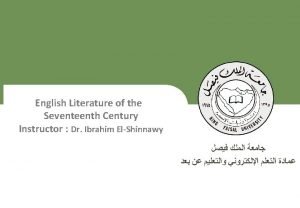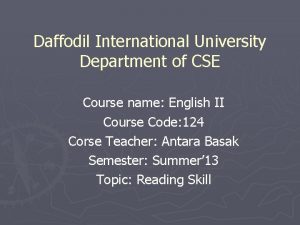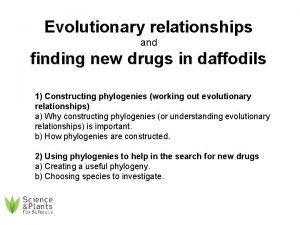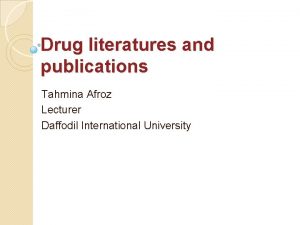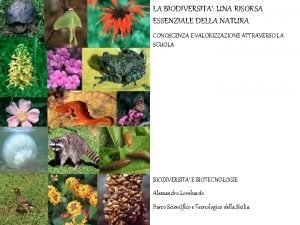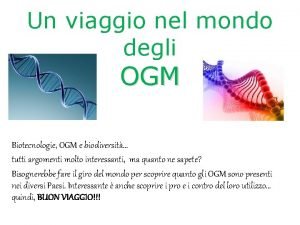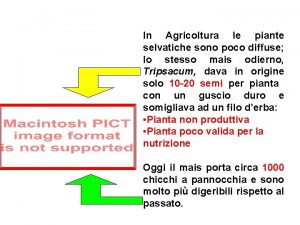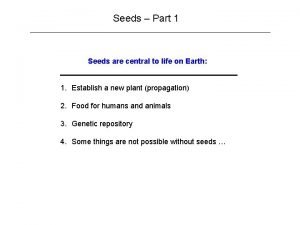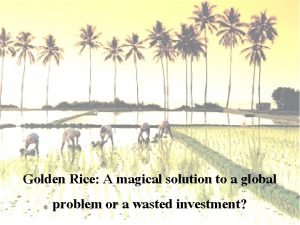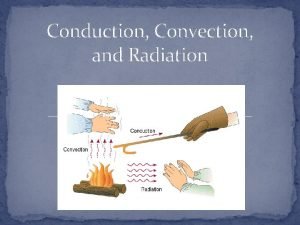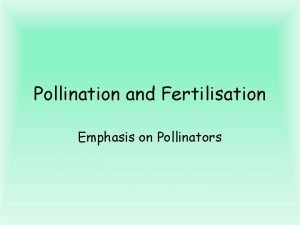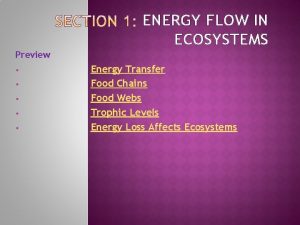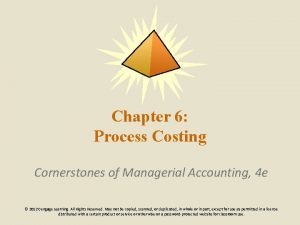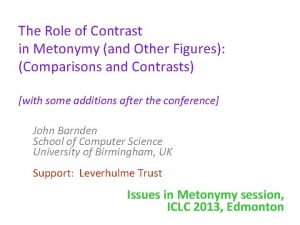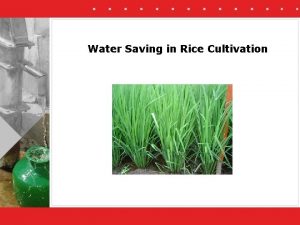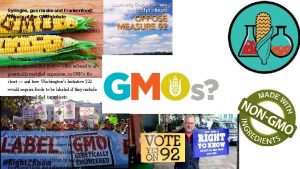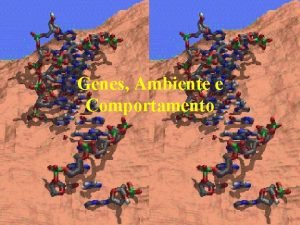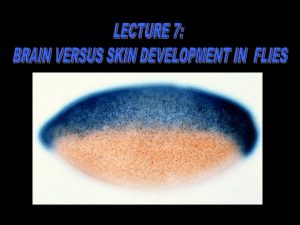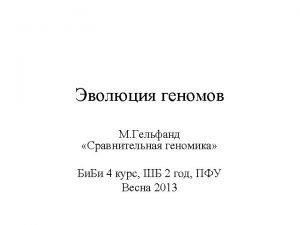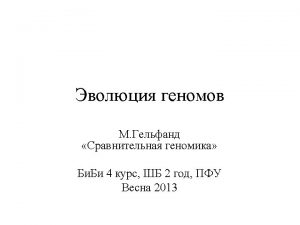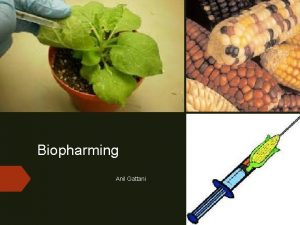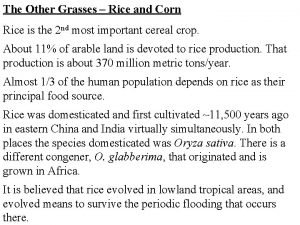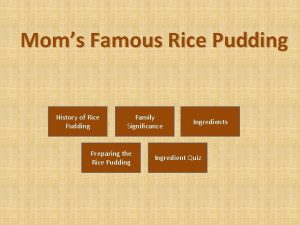Golden Rice or Frankenfood Scientists transferred daffodil genes
































- Slides: 32

Golden Rice or Frankenfood? • Scientists transferred daffodil genes into rice • Rice with beta-carotene may help prevent vitamin A deficiencies • Opponents fear unforeseen consequences of creating genetically modified organisms

Genetic Changes • Humans have changed the genetics of other species for thousands of years – Artificial selection of plants and animals • Natural processes also at work – Mutation, crossing over

Genetic Engineering • Genes are isolated, modified, and inserted into an organism • Made possible by recombinant DNA technology – Cut up DNA and recombine pieces – Amplify modified pieces

Discovery of Restriction Enzymes • Hamilton Smith studied how bacterium Haemophilus influenzae cut invading viral DNA • Discovered that bacteria have an enzyme that chops up viral DNA

Specific Cuts • Restriction enzymes cut DNA at a specific nucleotide sequence • Cuts leave “sticky ends” on DNA fragments that pair with matching cuts

Making Recombinant DNA 5’ G A A T T C 3’ C T T A A G one DNA fragment another DNA fragment 5’ G A A T T C 3’ 3’ C T T A A 5’ G

Making Recombinant DNA nick 5’ G A A T T C 3’ 3’ C 5’ T T A A G nick DNA ligase action G A A T T C C T T A AG

Using Plasmids • Plasmid: a small circle of bacterial DNA • Foreign DNA inserted into plasmid – is replicated and distributed along with plasmid • Plasmid becomes a cloning vector – delivers DNA into another cell

Cloning Vectors

Using Plasmids a A restriction enzyme cuts a specific base sequence everywhere it occurs in DNA. c The same enzyme cuts the same sequence in plasmid DNA. b The DNA fragments have sticky ends. e The DNA fragments and plasmid DNA are mixed with DNA ligase. f The result? A collection of recombinant plasmids that incorporate foreign DNA fragments. d The plasmid DNA also has sticky ends g Host cells that can divide rapidly take up the recombinant plasmids. Fig. 11 -3, p. 164

Gene Libraries • Cells that host fragments of cloned DNA – Genomic library

Where am I? 1. 2. 3. 4. 5. 123 Devilbiss Biology 101 SU US Earth

DNA Sequencing • Order of fluorescent bands indicates DNA sequence

Polymerase Chain Reaction • Sequence to be copied is heated • Primers are added and bind to ends of single strands • DNA polymerase uses free nucleotides to create complementary strands • Doubles number of copies of DNA

Polymerase Chain Reaction double-stranded DNA to copy DNA heated to 90°– 94°C primers added to base-pair with ends mixture cooled; base-pairing of primers and ends of DNA strands DNA polymerases assemble new DNA strands

Polymerase Chain Reaction mixture heated again; makes all DNA fragments unwind mixture cooled; basepairing between primers and ends of single DNA strands DNA polymerase action again doubles number of identical DNA fragments

DNA Fingerprints • Unique array of DNA fragments • Inherited from parents in Mendelian fashion • Even full siblings can be distinguished from one another by this technique

Analyzing DNA Fingerprints • DNA is separated by gel electrophoresis • Pattern of bands is used to – Identify or rule out criminal suspects – Identify bodies – Determine paternity

A DNA Fingerprint

DNA Sequence Data • Evolutionary trends • Potential therapies for genetic diseases • Data bases using computer technology

Genetics in Practice • Genetic engineering is used to change genetic makeup of organisms – Genes transferred between species (Transgenic organisms) – Genes modified and reinserted into same species

Transgenic Plants • Contain DNA from another species • New genes make crop plants less vulnerable to disease and pests • Use bacterial cloning vectors to insert foreign gene (Ti plasmid)

Transgenic Cotton • Resistant to herbicides • Insecticide gene

Genetically Engineered Bacteria • Produce medically valuable proteins • Breakdown environmental contaminants • Designed to survive only under narrow conditions

Transgenic Animals • Early experiments in mice – Injection of rat gene corrected a growthhormone deficiency – Injection of human growth-hormone gene produced giant mice • Human genes are now routinely transferred into animals to produce human proteins for use as drugs

Genetically Modified Animals

Gene Therapy For SCID-X 1 • Designed to cure “bubble babies” – Immune system can’t fight infection

Gene Therapy For SCID-X 1 • Retrovirus inserts normal allele into cultured stem cells • Modified stem cells returned to child’s bone marrow • Successfully created immune function • Also caused leukemia in some children

Who Gets Enhanced? • Eugenic engineering – Selecting for “desirable” human traits • How should we use gene therapy? • Who should decide what genetic traits can or should be altered?

Xenotransplantation • Human organs are in short supply • Pig organs are similar, but human body rejects them as foreign • Scientists work to knockout pig genes that trigger rejection • Can interspecies transplants introduce new diseases to humans?

“Frankenfood” • Genetically engineered foods are widespread in the US • Cut costs, reduce herbicide use, enhance yields • What effect will they have on humans and ecosystems?

Transgenic Mouse • With genes for fluorescent protein
 Linked genes and unlinked genes
Linked genes and unlinked genes Homeotic genes vs hox genes
Homeotic genes vs hox genes Linked genes and unlinked genes
Linked genes and unlinked genes To daffodils robert herrick summary
To daffodils robert herrick summary Daffodil university cse course
Daffodil university cse course Daffodil replicator
Daffodil replicator Daffodil principle
Daffodil principle Daffodil lower classifications
Daffodil lower classifications Non official compendia examples
Non official compendia examples Golden rice ogm
Golden rice ogm Golden rice ogm
Golden rice ogm Ingo gestring
Ingo gestring Golden rice
Golden rice Monocot seed
Monocot seed Golden fleece rice investment
Golden fleece rice investment Mais bt zanichelli
Mais bt zanichelli Golden rice zanichelli
Golden rice zanichelli Golden ratio and golden rectangle
Golden ratio and golden rectangle What is the golden ratio in art
What is the golden ratio in art Whats conduction convection and radiation
Whats conduction convection and radiation Persuasion
Persuasion How to calculate cost of goods transferred out
How to calculate cost of goods transferred out During pollination pollen is transferred from a stamen to a
During pollination pollen is transferred from a stamen to a How to calculate trophic efficiency
How to calculate trophic efficiency How is heat energy transferred
How is heat energy transferred Food diagram
Food diagram Examples of energy transfer
Examples of energy transfer Process costing problems and solutions doc
Process costing problems and solutions doc During conduction, thermal energy is transferred
During conduction, thermal energy is transferred Transferred epithet
Transferred epithet Figure of speech in on the grasshopper and cricket
Figure of speech in on the grasshopper and cricket Conduction or convection
Conduction or convection Transferred epithet
Transferred epithet



